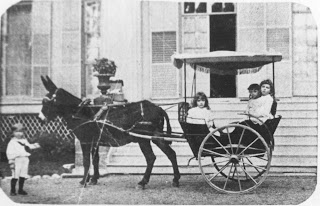O.L. as he was known, was born on August 23, 1884 in Newport, RI, fourteen months after his twin sisters. Perry Osborn, Ogden's lifelong friend, described him as being particularly devoted to his maternal grandmother Ruth Baylies Livingston, as well as his paternal grandfather, Darius Ogden Mills. D.O. Mills was a self-made man so it is possible that Ogden's closeness to his grandfather influenced his decision to forge a path in the political world apart from his family's business ventures.
 |
| Ogden, left, as a young child in front of Staatsburgh, circa 1888-1889 |
Ogden attended the Browning School located in Manhattan and graduated in 1901 just before he turned seventeen. That fall he entered Harvard where received a Bachelor of Arts degree in 1904 when he was just 19 years old. During the Fall of 1904 he decided to enter Harvard Law School. According to friend and fellow lawyer Perry Osborn, he "got through the business of learning in Browning School, Harvard College, and Harvard Law School rapidly and creditably by very spasmodic but nevertheless intense application. In college, he specialized in economics, languages and philosophy. His contemporaries thought of him as brilliant but unsteady and spoiled." In an atmosphere where so many were young, rich, and spoiled it is difficult to imagine what kind of behavior made Ogden seem "spoiled" to his contemporaries.
 |
| Ogden L. Mills during his college years. |
At Harvard, Ogden had a suite at Claverly Hall, which was one of the luxurious "Gold Coast" dormitories. At the time college housing was limited and lacking amenities so privately owned dormitories like Claverly Hall allowed wealthy students to pay for rooms that included amenities such as running water, electricity, steam heat, private bathrooms, electric bells, maid service, and sporting facilities. Claverly Hall was the first of seventeen "Gold Coast"dormitories built in the late - nineteenth and early twentieth centuries in the Harvard Square vicinity.
 |
| Claverly Hall at Harvard as it appears today. It was originally built in 1893. |
According to friends, during law school Ogden decided that he wanted to be a "real lawyer" and truly work at the profession. He graduated in 1907, passed the New York State Bar in 1908, and started working for the New York firm of Stetson, Jennings and Russell (now Davis Polk & Wardwell). President Grover Cleveland was a partner with this firm in-between his presidencies and the firm also represented J.P. Morgan's United States Steel Corporation. O.L. began as a clerk and he assisted in the preparation of cases for trial in city and municipal courts. He had an inclination towards advocacy rather than office work and after two or three years he was trying cases for the firm in all courts in addition to preparing, briefing, and arguing cases in the appellate courts. By 1914 he was a partner in the firm. In a newspaper interview later in life he reflected on his time as a lawyer, "I practiced law very seriously...There was a reason. I was possessed of a fortune, but I wanted to put myself, as a matter of personal pride, in a position where I was not dependent upon the income which I had inherited."
Even though Ogden worked as a lawyer, he was still involved with his family's business. He maintained an office at his father's office building and also became more involved with the family's philanthropic interests. He adopted more responsibility as his father grew older. Yet it was neither law nor the family business that was Ogden's true passion. He left the law because he felt that political activity on behalf of good government was more important than continuing to accumulate wealth. According to Ogden himself, he entered politics because he had "a bent in that direction, but more so because I concluded that a man with money should justify his existence - jump into the civic boat and take a turn at the oars." This sense of civic duty first led Ogden to begin working at the polls in 1909. He eventually worked his way up to district captain in the district where he lived in New York City.
Soon Ogden met a politically influential man named Herbert Parsons who became a mentor. Parsons was the chairman for the New York Republican County Committee and in 1911 Ogden became treasurer of the committee. He held this position for fifteen years and during that time assumed more responsibility and devoted much time and energy to Republican Party politics. In 1912, Ogden entered his first race for office, beginning a successful career that culminated in his appointment as Secretary of the Treasury in 1931. Ogden's younger years and education gave him the skills and tools he needed to successfully navigate the world of politics and build a name for himself that didn't depend on the prior success and prominence of his family. In future entries, we will explore Ogden's life as a politician; his wins, losses, and ideologies.
Staatsburgh State Historic Site has an exhibit devoted to Ogden Livingston Mills that is currently on view when you visit the site. To learn more about our programs and hours of operations, click here.
 |
| In later years after he was established in politics, O.L was on the cover of TIME Magazine. October 6, 1926 |
* This blog entry has been adapted from Susan Walker's research on Ogden Livingston Mills and an article published in the Fall 2003 edition of the Friends of Mills Mansion newsletter.


tiephiMsimp-se1981 Dan Johnson https://wakelet.com/wake/3ZoF98VRCcG5XF1JH6Zie
ReplyDeleteoldedovic